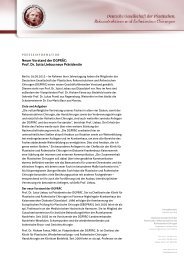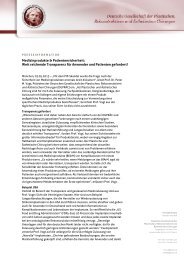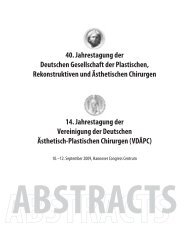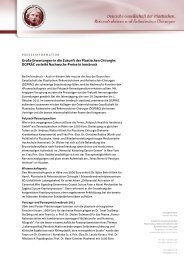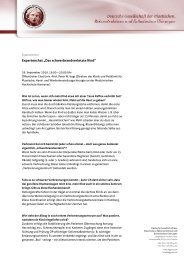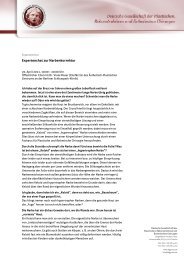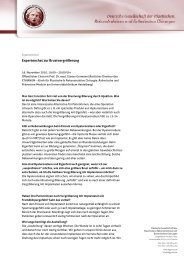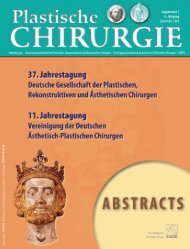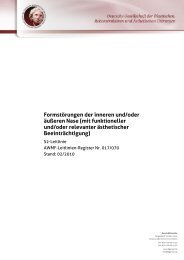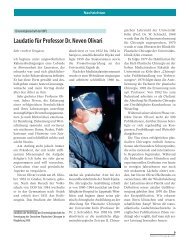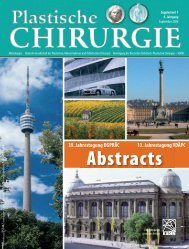ABSTRACTS
ABSTRACTS
ABSTRACTS
Sie wollen auch ein ePaper? Erhöhen Sie die Reichweite Ihrer Titel.
YUMPU macht aus Druck-PDFs automatisch weboptimierte ePaper, die Google liebt.
Abstracts<br />
formation führt zur Formation von tubulären Strukturen in den EDC-<br />
Kollagenschwämmen. EDC dient als zusätzlicher Cross-linker für die<br />
Kollagenfibrillen und bewirkt über die Stabilisierung einer größeren<br />
Porenstruktur eine verbesserte Proliferation. Diese Kollagenmatrizes<br />
können als „Drug-delivery-systems“ für Wachstumsfaktoren dienen und<br />
beinhalten die Möglichkeit der Transformation von pluripotenten<br />
mesenchymalen adulten Knochenmark-Stammzellen in viele Zelltypen.<br />
P18 Application of Vascular Endothelial Growth Factor to<br />
Enhance Prefabricated Skin Flap Survival in a Rat Model<br />
R. Meirer, R. Gurunluoglu, M. Shafighi, G. Huemer, H. Piza-Katzer<br />
Plastische und Wiederherstellungschirurgie, Universitätsklinik Innsbruck, Department of Plastic and<br />
Reconstructive Surgery and the Ludwig Boltzmann Institute for Quality-Control in Plastic Surgery, University<br />
Innsbruck<br />
An experimental study was conducted to evaluate the effect of adenovirus-mediated<br />
VEGF on the survival of prefabricated skin flaps in a rat<br />
model.<br />
Materials and Methods: Skin flaps (8 x 8 cm) were outlined on the anterior abdominal<br />
wall. Upper and lateral borders were incised and abdominal flaps<br />
were raised leaving the inferior skin border intact. Left epigastric vessels<br />
were ligated. An incision extending from the inguinal region to the lower<br />
leg was performed and the left femoral artery and vein in continuity with<br />
the saphenous vessels were dissected under the microscope and ligated<br />
distally to obtain a vascular pedicle of 4 cm. A cuff of muscle was left surrounding<br />
the pedicle. The pedicle was transposed and implanted underneath<br />
the abdominal flap with 8/0 microsutures. Next, thirty male Sprague-Dawley<br />
rats were randomly divided into three groups and received<br />
either saline (control group I, n=10), Ad-GFP (adenovirus encoding<br />
green fluorescent protein, group II, n=10) or Ad-VEGF perivascular<br />
intracutaneous injections (group III, n=10). Incisions were closed with<br />
running sutures. 21 days after the injections, the abdominal flaps were<br />
elevated as an island flap based solely on the previously implanted pedicle.<br />
These prefabricated skin flaps were then sutured back into place and flap<br />
viability was evaluated at day seven. Sections of flaps were examined<br />
histologically under electron and fluorescence microscopy.<br />
Results: There was evidence of green fluorescence protein at day 3, 7, 14<br />
and 21 in sections of skin flaps pretreated with Ad-GFP, indicating successful<br />
transfection of flap. We observed a statistically significant<br />
decrease in the percentage of flap necrosis in rats pretreated with Ad-<br />
VEGF compared to the control and to the Ad-GFP group. (Ad-VEGF: 10.2<br />
± 3.8 % vs. control: 43.1 ± 2.7 % (p





